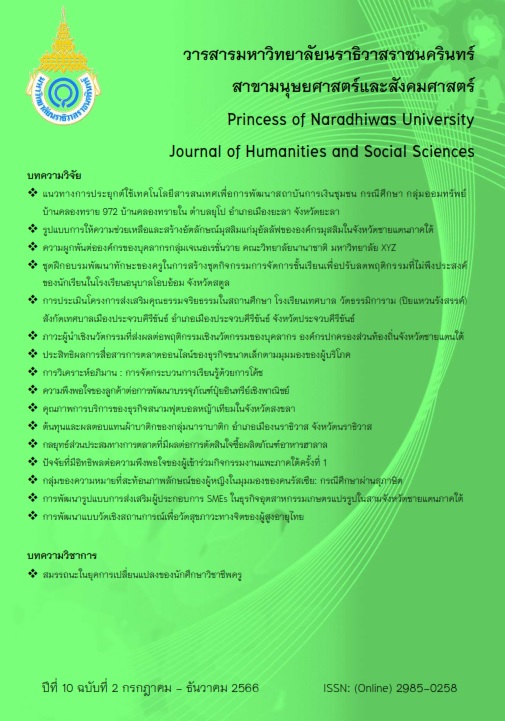A group of meanings that reflect the image of women from the perspective of Russian people: a case study of proverbs
Main Article Content
Abstract
This research examined a group of meanings that reflect the historical image of women from the perspective of Russian people by studying the proverbs or symbols related to women. The data were gathered from Russian proverb dictionaries and electronic sources, totaling 65 proverbs. The data were analyzed and categorized the meanings highlighting both positive and negative historical image of women in Russian context. The results indicated that Russians generally held more negative views towards women. The identified groups of women imagery portrayed in the proverbs include: 1) inconsistency and indecision; 2) societal responsibilities and role; 3 talkativeness and loudness; 4) intelligence; 5) conflict-making; 6) emotional centering; 7) value limitations and worthlessness; 8) stubbornness; and 9) unreliability. This study contributes to the understanding of relationship between language and culture perceptions, as well as the historical development of gender roles and attitudes in patriarchal prejudices within Russian society.
Article Details

This work is licensed under a Creative Commons Attribution-NonCommercial-NoDerivatives 4.0 International License.
References
กัญญ์วรา เจนพินิจกุล และเกวลี เพชราทิพย์. (2566). ภาพลักษณ์ประเทศไทยผ่านรายการโทรทัศน์จีน : กรณีศึกษารายการวาไรตี้ ทอล์กโชว์ “ซื่อเจี้ยชิงเหนียนซัว”. วารสารมนุษยศาสตร์และสังคมศาสตร์ มหาวิทยาลัยมหาสารคาม, 42(1), 7-21.
กัลยาณี กฤตโตปการกิต. (2563). สำนวนจีน : ภาพสะท้อนโลกทัศน์ของชาวจีนต่อสตรีจีน. วารสารจีนศึกษา มหาวิทยาลัยเกษตรศาสตร์, 13(1), 271-301.
กุหลาบ มัลลิกะมาส. (2537). วรรณคดีวิจารณ์. กรุงเทพฯ: มหาวิทยาลัยรามคำแหง.
ทัศนัย โคตรทอง. (2560). ภาพลักษณ์ผู้สื่อข่าวที่ถูกสะท้อนบทบาทผ่านภาพยนตร์ไทย (การค้นคว้าอิสระนิเทศศาสตรมหาบัณฑิต). มหาวิทยาลัยกรุงเทพ, กรุงเทพฯ.
นูรีดา อิบนิสุลัยมาน. (2565). ภาพสตรีในสุภาษิตมลายู. วารสารอักษรศาสตร์, 51(1), 83-104.
พจนานุกรมฉบับราชบัณฑิตยสถาน. (2554). ภาพลักษณ์. สืบค้นจาก https://dictionary.orst.go.th
พรทิพย์ พิมลสินธ์. (2540). ภาพพจน์นั้นสำคัญยิ่ง: การประชาสัมพันธ์กับภาพพจน์. กรุงเทพฯ: ประกายพรึก.
วรารัชต์ มหามนตรี. (2557). ภาษิต สำนวน : ภาพสะท้อนโลกทัศน์ของคนไทยต่อผู้หญิง. วารสารอารยธรรมศึกษา โขง-สาละวิน, 5(2), 9-58.
วิลาสินีย์ แฝงยงค์. (2564). ภาพผู้หญิงที่สะท้อนผ่านสุภาษิตอิตาเลียน. วารสารอักษรศาสตร์, 50(1), 83-104.
เสรี วงษ์มณฑา. (2541). ภาพพจน์นั้น...สําาคัญไฉน. กรุงเทพฯ: ธีระฟิลม์และไซเท็กซ์.
สำนักงานราชบัณฑิตยสภา. (2550). สุภาษิต. สืบค้นจาก http://legacy.orst.go.th/?knowledges=สุภาษิต-๒๕-สิงหาคม-๒๕๕๐
อาทิตย์ จิตรโท. (2558). ภาพลักษณ์ในเชิงลบของผู้หญิงในสำนวนสุภาษิตสเปน. วารสารมนุษยศาสตร์สังคมศาสตร์ มหาวิทยาลัยขอนแก่น, 31(1), 131-146.
อุบล เทศทอง. (2548). โลกทัศน์ต่อชายหญิง : ภาพสะท้อนจากภาษิตเขมร. วารสารดำรงวิชาการคณะโบราณคดี มหาวิทยาลัยศิลปากร, 4(2), 131-155.
Bychkova, E. A. (2020). Gender stereotypes in proverbs and sayings of the Russian language.New Horizons of Russian Studies, 9, 9-14.
Dal, V. I. (1879). Proverbs of the Russian People. St. Petersburg: M. O. Wolf.
Dal, V. I. (1957). Proverbs of the Russian People. Collection. Moscow.
Dictionary of proverbs and sayings. (n.d.). Cities of ladies don't last long. Retrieved from https://slovarick.ru/19/
Dictionary of the Russian Language. (n.d.). Image. Retrieved from https://gufo.me/dict/ozhegov/ образ
Folk art. (2023). 12 popular expressions, the meaning of which is not known to everyone. Retrieved from https://folkrussia.ru/rabota/zabegalas-kak-najda-znachenie-pogovorki.html
Fomicheva, A.P. (2020). The role of proverbs and sayings in shaping the image of a women in the Russian language picture of the world. "Social and humanitarian problems of education and professional self-realization "Social Engineer-2020", 273-277.
Journal of Foma. (2023). Woman: made from the rib of a man?. Retrieved from https://foma.ru/ zhenshhina-sotvorennaya-iz-rebra-muzhchinyi.html
Kovyneva, M. (2023). Why do they say "a woman with a cart - it's easier for a mare?. Retrieved from https://www.culture.ru/s/vopros/baba-s-vozu-kobyle-legche/
Martynova, A. N. & Mitrofanova, V. V. (1986). Proverbs, sayings, riddles. Moscow.
Moiposlovicy. (n.d.). Proverbs About Women. Retrieved from https://moiposlovicy.ru/zhenschina.html
Our Tatarstan. (2020). Women's minds that Tatar sums. Retrieved from https://dzen.ru/media/nashtatarstan/jenskie-umy-chto-tatarskie-sumy5edb c95d784aeb7d7a944576
Radio Sputnik Fm. (2018). What is the difference between a bazaar and a market?. Retrieved from https://bash.news/sputnik/uroki-russkogo/78348-chem-otlichaetsja-bazar-ot-rynka-9989
Shaimardanova, M. R. & Akhmetova, L. A. (2021). Value Representation of Gender Stereotypes through Paroemias Containing Gender Nomination (Based on English and Russian Proverbs). Philology. Theory & Practice, 14(10), 3249-3254.
The world of idiomatic phrases. (2023). Interpretation and origin of the idiomatic phrase “there's no way to beat it into thick head”. Retrieved from https://www.fraze.ru/index.php/frazeol ogizm/na-bukvu-h/khot-kol-na-golove-teshi
The world of idiomatic phrases. (2023). The origin, meaning and use of the proverb "Baba (while) flies from the stove, seventy-seven thoughts will change her mind." Retrieved from https://fraze.ru/index. php/poslovitsy-pogovorki/poslov-na-bukvu-b/baba-poka-s-pechi-letit
Tokareva, N. A., Kirillova, T. S. & Konnova, O. V. (2019). Gender concepts of «woman, mother, girl» in Russian, English and Chinese phraseology. Bulletin of Kalmyk university scientific journal, 110-116.
Trusov, M. (2020). Seven Fridays a week: the meaning and origin of the expression. Retrieved from https://dzen.ru/media/id/5c1b6cb3d07efb00a93f3b7a/sem–piatnic–na–nedele-znach enIe–I–proIshojdenie-vyrajeniia5edf24d375cc01341718705a
Zhang, Q. (2020). The image of a man and woman on the example of Russian and Chinese Linguocultural systems (based on the analysis of phraseological units). The world of science, culture and education, 2(81), 466-468.


